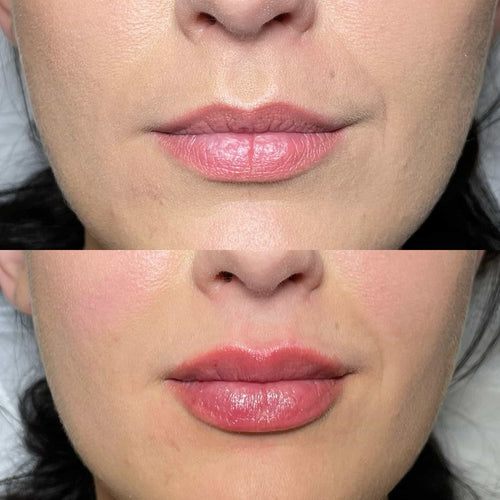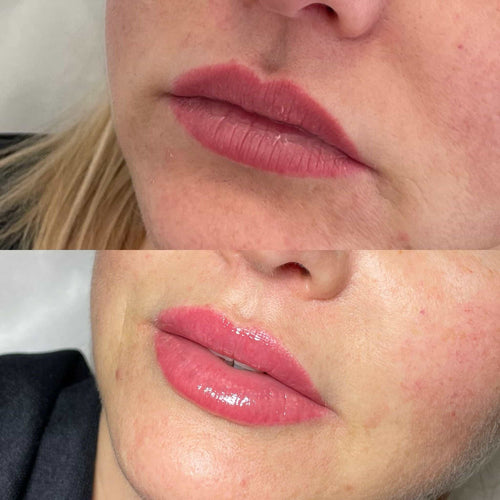Get Started with Your Dermal Filler Consultation with Dr. Laura Geige
Factors Influencing Swelling Time
Injection Technique
Swelling following lip filler injections is a natural part of the healing process and usually subsides within a few days.
Several factors can influence the duration and severity of swelling:
- Type and Volume of Filler Used
- Individual Patient Factors
- Injection Technique
- Lifestyle Habits
- Post-Treatment Care
Hyaluronic acid fillers, which are most common, tend to cause less pronounced swelling compared to temporary volumizers containing collagen.
Larger injection volumes naturally lead to more significant swelling.
Skin thickness and sensitivity vary among individuals. Thinner skin may show swelling more prominently.
Certain medical conditions like diabetes or allergies can also affect healing and swelling.
The injector’s experience and technique play a crucial role in minimizing swelling. Proper needle depth and injection spread help to avoid excessive trauma to the tissue.
Avoiding alcohol, smoking, and strenuous activities for the first few days after treatment can reduce inflammation.
Staying hydrated is essential for optimal healing.
Following the injector’s instructions carefully regarding ice packs, elevation, and gentle cleansing is vital to manage swelling.
In most cases, the initial swelling peaks within a day or two after treatment and gradually subsides over several days.
Minor residual swelling may persist for up to a week or even longer in some individuals.
Type of Filler Used
Swelling following lip filler injections is a common and usually temporary side effect. The duration of swelling varies considerably between individuals and depends on several factors.
Here are some key factors influencing swelling time after lip filler injections:
- Type of Filler Used:
- Amount of Filler Injected:
- Injection Technique:
- Individual Healing Rate:
- Other Medical Conditions or Medications:
- Sun Exposure and Heat:
- Smoking:
Different types of fillers have varying compositions, densities, and particle sizes. Hyaluronic acid (HA) fillers are commonly used for lip augmentation and tend to cause less swelling than collagen or silicone-based fillers.
Larger injections naturally lead to more pronounced swelling as there’s a greater volume introduced into the tissue.
An experienced injector who uses precise techniques will minimize trauma to the tissues, potentially reducing swelling.
Everyone’s body responds differently to injections. Some people heal quickly and experience minimal swelling, while others may take longer.
Conditions like diabetes or certain medications can affect healing and potentially increase swelling.
Excessive sun exposure or heat can exacerbate swelling.
Smoking hinders blood flow and slows down the healing process, potentially prolonging swelling.
It’s important to follow your injector’s post-treatment instructions carefully, which typically include avoiding strenuous activity, applying ice packs, and keeping the area clean. Most swelling subsides within a few days to a week, but it can sometimes take up to two weeks for complete resolution.

Individual Body Response
Several factors influence how long it takes for swelling to subside after lip filler injections. Understanding these factors can help manage expectations and prepare for post-procedure recovery.
The type of filler used plays a significant role. Hyaluronic acid fillers, which are the most common, tend to cause less intense swelling than other types of fillers.
The amount of filler injected also influences swelling. Larger injections will naturally result in more pronounced and longer-lasting swelling compared to smaller ones.
Individual body responses vary widely. Some people’s bodies react with greater inflammation than others, leading to more noticeable and prolonged swelling. This variability can be influenced by factors like genetics, overall health, and previous experiences with filler injections.
Technique used during injection also matters. Precise injection techniques minimize trauma to surrounding tissues, potentially reducing swelling.
Lifestyle choices can impact recovery time. Engaging in strenuous activity or excessive alcohol consumption after the procedure might prolong inflammation.
Following the post-injection care instructions provided by your practitioner is crucial. This may include applying ice packs, avoiding touching the area, and staying hydrated.
In most cases, initial swelling peaks within a few days and gradually subsides over the following week or two. However, some residual puffiness might persist for several weeks as the filler settles into its final position.

Timeline for Swelling Reduction
Initial 24-72 Hours
Reserve a Dermal Filler Consultation with Dr. Laura Geige
During the first 24 to 72 hours after lip filler injections, swelling is at its peak.
This is a normal physiological response to any injection and is caused by the body’s inflammatory reaction to the hyaluronic acid gel.
While most swelling subsides significantly within these first 72 hours, some individuals may experience lingering puffiness for up to a week.
It’s important to note that swelling can vary greatly depending on several factors such as the amount of filler used, the individual’s metabolism, and their sensitivity to injections.
During this initial period, it’s essential to follow your injector’s post-treatment instructions carefully. This typically involves applying ice packs for 15-20 minutes at a time, several times a day, to help minimize swelling.
Avoiding strenuous activity and alcohol consumption can also aid in reducing inflammation.
It’s crucial to avoid touching or massaging the treated area, as this can exacerbate swelling and potentially cause bruising or uneven distribution of the filler.
Week One
In the first week after lip filler treatment, you’ll likely experience significant swelling. The extent of swelling can vary depending on factors such as the amount of filler used, individual healing rates, and the specific injection technique.
During the first 24-48 hours, expect moderate to severe swelling. This is normal and a part of the body’s natural inflammatory response to the procedure. Your lips may appear noticeably larger than intended, and you might experience some tenderness or discomfort.
By day 3-4, the peak swelling should have subsided somewhat. You might still see noticeable puffiness, but it will be less pronounced compared to the initial days. During this time, applying cold compresses can help manage any lingering inflammation.
As you enter the latter half of week one (day 5-7), the swelling will continue to gradually decrease. Your lips should start to look closer to their natural shape and size. However, some residual puffiness might persist, especially around the injection sites.
It’s important to remember that everyone heals differently, so the timeline for swelling reduction can vary. Be patient and allow your body time to adjust. Follow your injector’s post-treatment instructions carefully to ensure optimal healing and minimize any potential complications.
Beyond the First Week
After the initial swelling from lip filler subsides in the first week, the timeline for further reduction can vary depending on several factors.
Here’s a general guideline:
- Week 2-3: Most noticeable swelling diminishes significantly. You’ll likely see a more defined shape emerging.
- Week 4-6: Continued gradual reduction of residual swelling, with lips becoming less puffy and more natural in appearance.
- Beyond Week 6: Minor swelling may linger for several weeks or even months. This is typically subtle and doesn’t significantly impact the final look of the treatment.
Factors influencing swelling duration:
- Amount of filler injected
- Individual healing rate
- Injection technique
- Lifestyle (e.g., smoking, alcohol consumption)
- Overall health
- Reduces inflammation by constricting blood vessels.
- Numbs the area, alleviating discomfort.
- Minimizes bruising by reducing blood flow to the treated site.
- Helps maintain a more natural shape during initial swelling.
-
How to Elevate Your Head Effectively:
-
Use an extra pillow or two to prop your head up while sleeping.
-
Consider using a wedge pillow, which provides consistent support and can be adjusted for comfort.
It’s important to note that everyone heals differently.
Some individuals may experience minimal swelling beyond the initial week, while others may take longer for complete reduction. If you have concerns about swelling, consult with your injector who can provide personalized guidance based on your specific case.
Managing Lip Filler Swelling
Applying Ice Packs
Managing lip filler swelling is crucial for achieving optimal results and minimizing discomfort after treatment.
Book a Consultation for Dermal Fillers with Dr. Laura Geige Today
One of the most effective methods for reducing swelling is applying ice packs.
Here’s a detailed guide on how to apply ice packs for managing lip filler swelling:
1. **Timing is Key:** Begin applying ice packs as soon as possible after your procedure. This helps constrict blood vessels and minimize inflammation.
2. **Preparation:** Wrap an ice pack in a thin towel or cloth to prevent direct contact with the skin, which could cause irritation.
3. **Application:** Gently apply the ice pack to the treated area for 10-15 minutes at a time, several times throughout the day. Avoid excessive pressure or prolonged application, as this can damage the skin.
4. **Frequency:** Repeat the icing process every 2-3 hours, especially during the first 24-48 hours post-treatment.
Benefits of Ice Packs
*
*
*
*
Remember to follow your provider’s specific post-treatment instructions, as they may have additional recommendations for managing swelling.
Avoiding Heat and Sun Exposure
Managing lip filler swelling is a crucial aspect of achieving natural-looking, smooth results. Here are some effective strategies to minimize and manage post-treatment puffiness:
1. Cold Compresses:
Immediately after your treatment, apply ice packs or cold compresses to the treated area for 10-15 minutes at a time, several times throughout the day. This helps constrict blood vessels and reduce inflammation.
2. Elevation:
Keep your head elevated while resting. Prop yourself up with pillows to encourage drainage and minimize fluid buildup in your lips.
3. Gentle Massaging:
After the initial 24 hours, you can gently massage your lips to help disperse any remaining swelling. Use light, circular motions to stimulate blood flow and lymphatic drainage.
4. Hydration:
Drink plenty of water to keep your body hydrated. This aids in flushing out excess fluids and promoting healing.
5. Avoid Heat and Sun Exposure:
Heat can exacerbate swelling, so avoid saunas, hot tubs, or prolonged exposure to direct sunlight for at least a week after your treatment. The sun’s UV rays can also irritate the treated area and delay healing.
6. Over-the-Counter Medications:
Consult with your doctor or nurse practitioner about using over-the-counter anti-inflammatory medications, such as ibuprofen or arnica, to help manage swelling and discomfort.
Remember that everyone’s healing process is different. It typically takes several days for the initial swelling from lip filler to subside. If you have any concerns about excessive or persistent swelling, contact your injector immediately.
Elevating Your Head
Managing lip filler swelling is key to achieving optimal results and minimizing discomfort after treatment.
One of the most effective ways to manage swelling is by elevating your head while sleeping.
Here’s why:
*
Gravity’s Effect:
Lying flat allows fluid, including excess serum injected into the lips, to pool towards the face. Elevating your head helps counteract gravity’s pull, reducing fluid accumulation and swelling.
*
Improved Circulation:
When your head is elevated, blood circulation in the area is optimized. This promotes faster removal of waste products and reduces inflammation, aiding in quicker swelling reduction.
By elevating your head during sleep, you create a more conducive environment for healing and minimize swelling following lip filler treatment.
- Why Breadcrumbing Is One Of The Most Subtle Forms Of Manipulation In Relationships - November 11, 2025
- What Is The Average Age For Cheek Fillers? - November 10, 2025
- What Age Is Too Late For A Facelift? - November 7, 2025
